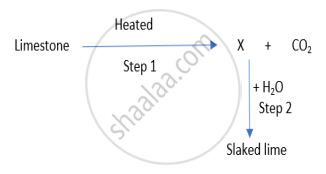Advertisements
Advertisements
Question
Which changes occur during chemical changes?
Solution
The chemical composition of substance changes during chemical changes i.e., new substances are formed.
APPEARS IN
RELATED QUESTIONS
A solution of a substance ‘X’ is used for white washing.
- Name the substance ‘X’ and write its formula.
- Write the reaction of the substance ‘X’ named in (i) above with water.
Find the odd man out:
Camphor, Ammonium Chloride, Naphthalene balls, Sugar
One of the following is an endothermic reaction. This is:
(a) combination of carbon and oxygen to form carbon monoxide
(b) combination of nitrogen and oxygen to form nitrogen monoxide
(c) combination of glucose and oxygen to form carbon dioxide and water
(d) combination of zinc and hydrochloric acid to form zinc chloride and hydrogen
A silvery-white metal X taken in the form of ribbon, when ignited, burns in air with a dazzling white flame to form a white powder Y. When water is added to powder Y, it dissolves partially to form another substance Z.
(a) What could metal X be?
(b) What is powder Y?
(c) With which substance metal X combines to form powder Y?
(d) What is substance Z? Name one domestic use of substance Z.
(e) Write a balanced chemical equation of the reaction which takes place when metal X burns in air to form powder Y.
What type of chemical reaction take place when a magnesium wire is burnt in air?
What type of chemical reaction take place when ammonia and hydrogen chloride are mixed?
What do you understand by a chemical bond ?
What do you observe when solid lead nitrate is heated?
Fill in the blank
A reaction in which two or more substances combine to form a single substance is called a ............ reaction.
Classify the following reaction as combination, decomposition, displacement, precipitation and neutralization. Also balance the equation.
\[\ce{CaCO3_{(s)} ->[heat]CaO_{(s)} + CO2_{(g)}}\]
What are chemical combination or synthesis reactions ? Chemical combination or synthesis:
A student prepared an aqueous solution of CuSO4 in beaker X and an aqueous solution of FeSO4 in beaker Y. He then dropped some iron pieces in beaker X and some zinc pieces in beaker Y. After about 10 hours he observed that the solutions in X and Y respectively appear:
(A) blue and green
(B) colourless and pale green
(C) colourless and light blue
(D) greenish and colourless
What effect does an increase in concentration of H+ (aq.) in a solution have on the pH of solution?
Explain the terms with examples.
Combination reaction
Classify the following reaction into different type:
CaO(s) + H2O(l) → Ca(OH)2(aq)
Classify the following reaction into –
- Direct combination
- Decomposition
- Displacement
- Double decomposition
The reaction is – Molten zinc at high temperatures, burns in air to give zinc oxide.
Give a balanced equation for –
A direct combination reaction involving two elements, one of which is a non-metal
Select the correct answer for the statement given below:
The product formed during direct combination reaction of carbon dioxide and water.
Give a balanced equation for the following type of reaction:
A reaction of direct combination i.e. synthesis in which twp gases combine to give another gas – which turns lime water milky.
H2(g) + Cl29(g) → 2HCl(g) is a ______
The number of products formed in a synthesis reaction is ______
Define a combination reaction. Give one example of an exothermic combination reaction.
Which of the following are exothermic processes?
(i) Reaction of water with quick lime
(ii) Dilution of an acid
(iii) Evaporation of water
(iv) Sublimation of camphor (crystals)
Combustion reactions are always ____________.
In which of the following chemical equations, the abbreviations represent the correct states of the reactants and products involved at reaction temperature?
The Salt Story
From: The New Indian Express 9 March 2021
The salt pans in Marakkanam, a port town about 120 km from Chennai are the third largest producer of salt in Tamil Nadu. Separation of salt from water is a laborious process and the salt obtained is used as raw materials for manufacture of various sodium compounds.
One such compound is Sodium hydrogen carbonate, used in baking, as an antacid and in soda acid fire extinguishers.
The table shows the mass of various compounds obtained when 1litre of sea water is evaporated.
| COMPOUND | FORMULA | MASS OF SOLID PRESENT /g |
| Sodium Chloride | NaCl | 28.0 |
| Magnesium Chloride | MgCl2 | 8.0 |
| Magnesium Sulphate | MgSO4 | 6.0 |
| Calcium Sulphate | CaSO4 | 2.0 |
| Calcium Carbonate | CaCO3 | 1.0 |
| TOTAL AMOUNT OF SALT OBTAINED | 45.0 | |
Which compound in the table reacts with acids to release carbon dioxide?

Identify the correct option from the given table which represents the type of reactions occurring in step 1 and step 2.
Balance the following chemical equation and identify the type of chemical reaction.
`"CaO"("s") + "SiO"_2("s") -> "CaSio"_3("s")`
Read the text below and answer the questions that follow:
A small amount of hydrochloric acid was taken in a test tube. The test tube was heated. A glass rod was dipped in the ammonia solution and held on the top of the test tube. A white smoke was seen emanating from the tip of the glass rod.
- What must have happened?
- Which colour of gas is formed?
- Write the chemical equation for the reaction.
A clear solution of slaked lime is made by dissolving Ca(OH)2 in an excess of water. This solution is left exposed to air. The solution slowly goes milky as a faint white precipitate forms. Explain why a faint white precipitate forms, support your response with the help of a chemical equation.
A metal ribbon 'X' bums in oxygen with a dazzling white flame forming a white ash 'Y'. The correct description of X, Y and the type of reaction is:
